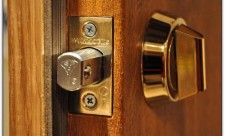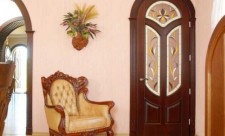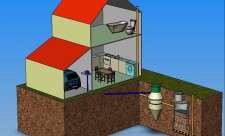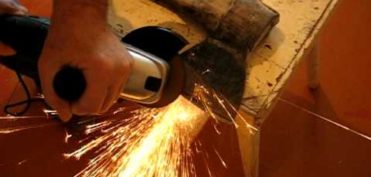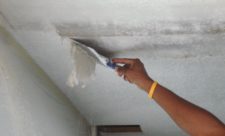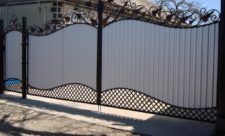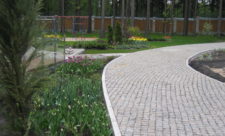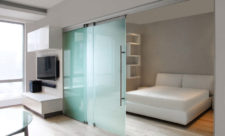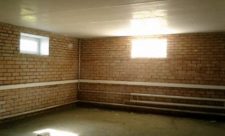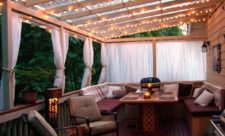
How to organize the backlight of fountains, pools and water bodies with their own hands Baths, saunas and pools,Lighting,Useful advice
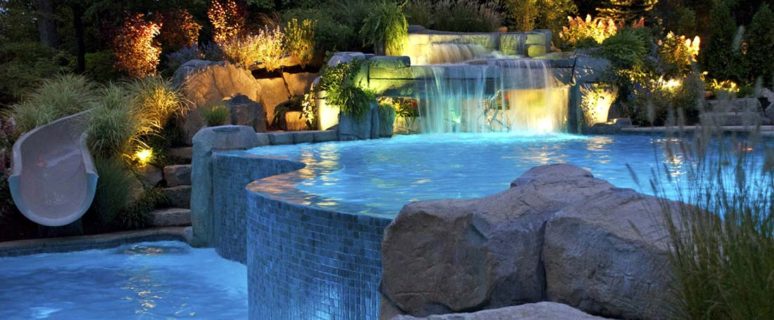
Artificial reservoir, swimming pool or fountain can be attractive even at night, if skillfully organized their backlight. It is not so difficult to fulfill such work on its own, since there are practically no additional skills, but you have to spend some time.
Content
Rules for installing lighting devices for highlighting in fountains, pools and water bodies
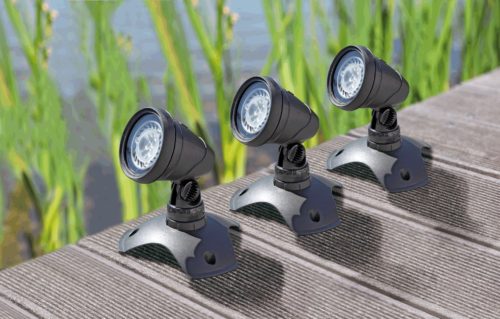
Water is a light conductive medium that has a high absorption coefficient of the spectral wave range. Therefore, during the organization of the backlight, you need to adhere to some aspects.
- When planning the backlight of the water stroit of the pool or fountain, the most important point is to ensure security for others. Since the liquid is a well-conductive electrical environment, the use of classic lighting devices in this case is excluded.
- The most common lamps for lighting in conditions of high humidity are sealed devices with a voltage of 12 V, and modern LED technologies and are used from 5 V to 3.5 V.
- In order for the lighting to be uniform throughout the water, the devices should be arranged at a distance of at least 60 cm, but not more than 100 cm from the surface of the water.
- Lamps, located at a depth of more than 1 m, will not be able to provide uniform backlight. In this case, it is necessary to increase the power of the lamps, which leads to too much energy consumption.
- Installing the lamps at a distance of less than 60 cm from the surface of the water branch is impractical, because it will not be possible to achieve the effect of the lighting volume. Low scattering light waves under water will be the main disadvantage.
- For water bodies, a depth of less than 50 cm, the underwater luminaires will not be able to provide the expected action, so it is best to apply the backlight of the surface type. This illumination plan can be achieved using floating light sources with directional lighting. The original game of water and light can be achieved if there are lamps on the contour of the fountain and send the rays to the base of the rising jet.
- To properly configure the synchronous supply of the voltage to the lighting lamps, not far from the reservoir, centralized transformers are placed or the instruments are connected using a pulse-based power supplies.
Backlight of fountains and pools: types of devices
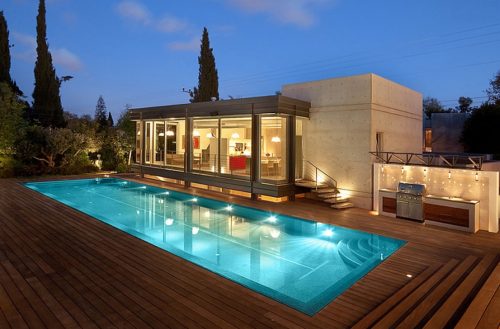
Today there are 2 main types of illumination. Consider them in more detail.
Underwater backlight
- Rays that pass through the waterstroke, visually make more than any, even the smallest, reservoir. The water is overflowing with different color shades and flickers mysteriously.
- The reservoir should not be too deep - no more than 1 m, otherwise the glow will not be able to make a highway through a large layer of water.
- Electrical appliances should be equipped with good insulation so that the moisture could not affect them. Therefore, during the acquisition of lamps for underwater lighting, you need to well check their quality.
- Data voltage devices is usually no more than 12 W. One of the most popular species of such devices are lamps located near or on the water surface.
Superwater backlight
- The surface type of lighting is set several times easier. In this case, the lighting devices are mounted outside. This is an order of magnitude safer, but also the species is not so beautiful.
- With this type of highlighting, it is important to observe the state of water, since if foreign objects fall into it, they are very clearly visible due to such lighting.
How to organize a backlit with your own hands: Choose light sources
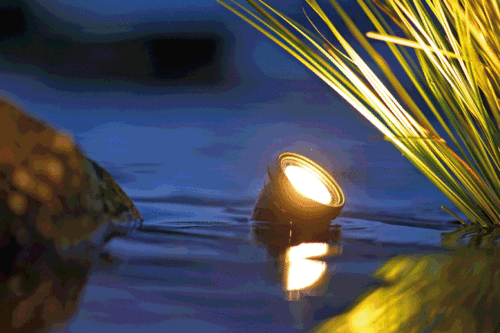
In external lighting devices, incandescent lamps usually use. It is recommended to put some other types of lamps. Their main distinctive feature is a tightness. Consider the main types of appliances for underwater lighting.
- Halogen lamps. Such sources have a powerful light beam, which can be sent to even the most distant places of the pool or reservoir. To change the color solution, various light filters can be applied.
- A distinctive feature of LEDs is their flexibility. They are best suited to illuminate the reservoirs of unusual forms. The maximum power of such lamps is 15 watts. The service life of high-quality devices is up to 11 years. When the lamp is turned on immediately lights up with a bright light, after which it slowly begins to fade. These lamps are good in that they do not heat up and are resistant to mechanical damage. However, they are glowing only by a certain tint. For this reason, they are usually installed by groups in one place, and then the console creates beautiful color combinations. At its cost and energy consumption, the LEDs exceed halogen lamps.
- Fiber optic devices are not terrible water. They are dielectrics, but as protection, their body is still separated by sealed materials. Sources of light are lightweight veins that are connected to the projector. The main plus of such devices is that they can operate at different temperatures: from -60 ° C to +60 ° C.
Backlight Fountain
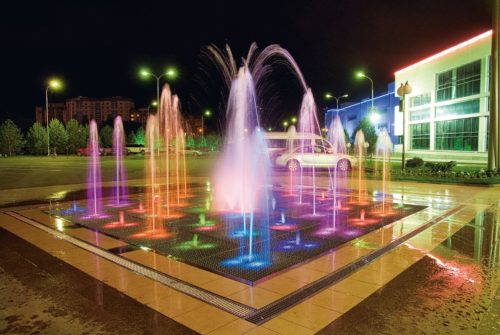
When organizing the highlighting of the fountains, the same lamps are used as for other types of water bodies. You can use underwater and surface devices. Luminaires can be installed on a fountain nozzle, which will make it possible to achieve the effect of the jet backlight from the bottom. Today there are several different types of spotlights that can be combined with each other, consider them more.
- Emitting light bulk type. They are used for underwater illumination.
- Sources designed to illuminate individual parts using reflected light reflectors.
- Devices with a beam of a diverging type that are more suitable for highlighting individual water jets.
- Instruments with a bunch of parabolic equations that are used if the jet of water should create a variety of compositions.
- Luminaires with an optical system will allow each individual jet to transfix the colors of the rainbow.
- Often, gas-discharge lamps are used in private construction. They are more famous as gas pipes. Such devices have the appearance of hollow capsules, at the ends of which spaced electrodes are located. The pipes themselves are made of glass, and the total color glow of the lamp depends on the gas inside:
- if neon is placed inside, the glow will be decorated in red;
- about the presence of helium shows the illumination of yellow color;
- the argon tube as a result will give blue lighting;
- when mixing neon with mercury gases, blue turns out.
A richer color scheme will have tubes covered with inside with phosphor. Such devices can continuously work for 500 hours.
Highlighting the fountain with your own hands: nuances
- In order to independently set the backlight for fountains, ponds and pools, it is necessary to take into account the mass of the nuances. It is best to entrust the issue of lighting the reservoir to those skilled in the art, but those who want to try their strength and do this on their own, first need to consult with professionals.
- During the edge of the reservoir illumination, it is necessary to ensure safe conditions for the work of people. Water is an excellent guide, so the use of conventional devices running from alternating electricity with a voltage of 220 V should be excluded.
- Most of the modern lighting sources are intended for permanent operation at a low voltage of 12 V, which will be completely safe for a person. It is extremely rare to find instruments operating in power in 5 V or 3.5 V.
- To competently adapt the network voltage, you need to install power supplies at a short distance from the reservoir. They can be both transformer and impulsive. And all the backlight of the reservoir perimeter will already be connected to power sources.
- Often the fountain lighting nutrition elements can go in one set with security unit. Such a device is equipped with sufficient protection for controlling current leakage, which may occur at points where insulation is low quality.
- ІР68 is the minimum allowable protective standard from moisture impact for such devices. This level of the fuse causes the normal functioning of all appliances under water.
- Volumetric lighting, due to which all the flows of the fountain glow in full length, make it very simple. This establishes a complex parallel backlight for all jets. One emitter should be located under the nozzle, and the other is to be placed in the area where the jet falls on the surface of the water. This lights the lighting of the entire water flow. When using only one luminaire, which is located under the nozzle, the bell tile effect occurs.
Making the backlight of the fountain for the pond
- During the installation of lighting for any artificial reservoir, some factors should be taken into account. First of all, it is continuous interaction with water and the need to allocate sufficient time for work.
- The main feature of special devices for the backlight is a complete set of handwrites. They are needed to feed to lamps of energy and eliminate moisture in them.
- Some lighting devices are supplied with a prepared wire for connections, but most of the models need to be connected manually. When connecting the backlight, pay attention to the following recommendations:
- during installation, it is best to use the wires with double insulation, since it provides more qualitative protection against moisture;
- from the outside, the cable must be round, which will allow it better to fix it in the Hermovhod;
- the contact location of the lighting device, made of the rubber seal, should not coincide with any irregularities of the cord, for example, relief inscriptions or cuts;
- the edge of the reservoir lighting should not be carried out without an electric line of a three-wire type, which is obliged to consist of grounding and two power cables;
- the cord cross-section should be seamless in accordance with the load-acting, and when calculating its optimal value, you need to use the correspondence: 5 A per 1 square meter. mm cord cross section;
- the lowering transformer needs to be located in a place where moisture does not fall;
- when connecting to the network you need to use waterproof sockets.
Basin and Pond Illumination
In private construction and on household plots, such a scenery is often used as a small pond. For a beautiful design, it is sometimes not enough to simply create a reservoir original, decorate with plants and decor, it is important to correctly highlight the water surface. It is for this purpose that lighting devices are installed on the plots.
On the photo presented on the network, the backlight of the pond may look like fabulously and so well thought out. Images are very much and they all differ in the degree of difficulty of work. With their help, you can learn original illumination options using different types of lamps, as well as pick up something more suitable in each case.
You can decorate your pond no worse than in the photo. To do this, you only need to show fantasy and allocate some time.
LED backlight pool
- LED luminaires are usually located under water, from where the reservoir lighting is carried out. More beautiful view can be obtained if you correctly pick up the angle of inclination of each lamp. With the help of point sources, they usually do not illuminate the entire territory of the pools, and only some of their places. All other areas are most often left in the atmosphere of a mysterious twilight.
- The lamps of this type can be burning only in one color, so their placement and color combination need to think good. Such light sources are universal, so they can be placed both under water and above its surface.
- An interesting feature of LED lamps is to have the ability to program them. They can illuminate the pool in some time intervals or shine all the rainbow colors in turn.
Decorative backlight of the pond
- To set the decorative backlight, you need to purchase the following items:
- a slide transformer that will have a voltage of 12 V at the output;
- low voltage lamps with an increased level of security;
- cable.
- Usually, those that correspond to the following conditions are selected as decorative luminaires:
- they must be approached by water in size;
- the combination of the light source with the design of the area is also an extremely important aspect.
- Most often, decorative lamps are used in the form of interesting figures, in which the lamps themselves are built. The advantage of such options is that they are:
- can work on solar panels;
- possess various forms;
- not too expensive;
- beautifully look at.
- Such lighting exists for both surface and underwater type illumination.
- Spleensing floating devices are very popular. All objects of such an installation are connected using a cable, and the power is supplied by a transformer. Such options can work from both the network and solar panels. Each element can be attached to the bottom with the help of hooks so that they are not demolished by the wind in one point. The lamps are recommended to immerse a little under the water, attaching goods to them.
- Another type of common lamps for the reservoir illumination are floating balls. The photocell is embedded in them, and there is a solar panel. In diameter, such light sources are about 155 mm, and there is a possibility of changing the color of the glow.
Highlighting the pond at the cottage: Recommendations
When setting the backlight into a private pond, an important condition is the safety of the reservoir. To achieve such a result, you need to comply with the following conditions during the installation of the lighting:
- wiring will need hermetic;
- all items must have reliable insulation, which does not fail with water in contact;
- in case of electrical leakage, it will necessarily need an automatic breaker.

